
Dame Agatha Mary Clarissa Christie, Lady Mallowan, was an English writer known for her 66 detective novels and 14 short story collections, particularly those revolving around fictional detectives Hercule Poirot and Miss Marple. She also wrote the world's longest-running play, the murder mystery The Mousetrap, which has been performed in the West End since 1952. A writer during the "Golden Age of Detective Fiction", Christie has been called the "Queen of Crime". She also wrote six novels under the pseudonym Mary Westmacott. In 1971, she was made a Dame (DBE) by Queen Elizabeth II for her contributions to literature. Guinness World Records lists Christie as the best-selling fiction writer of all time, her novels having sold more than two billion copies.

Murder on the Orient Express is a work of detective fiction by English writer Agatha Christie featuring the Belgian detective Hercule Poirot. It was first published in the United Kingdom by the Collins Crime Club on 1 January 1934. In the United States, it was published on 28 February 1934, under the title of Murder in the Calais Coach, by Dodd, Mead and Company. The UK edition retailed at seven shillings and sixpence (7/6) and the US edition at $2.

Death in the Clouds is a work of detective fiction by British writer Agatha Christie, first published in the US by Dodd, Mead and Company on 10 March 1935 under the title of Death in the Air and in the UK by the Collins Crime Club in July of the same year under Christie's original title. The US edition retailed at $2.00 and the UK edition at seven shillings and sixpence (7/6). The book features the Belgian detective Hercule Poirot and Chief Inspector Japp.
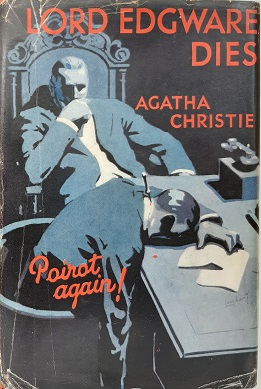
Lord Edgware Dies is a work of detective fiction by British writer Agatha Christie, published in the UK by the Collins Crime Club in September 1933 and in the US by Dodd, Mead and Company later in the same year under the title of Thirteen at Dinner. Before its book publication, the novel was serialised in six issues of The American Magazine as 13 For Dinner.

The Mystery of the Blue Train is a work of detective fiction by British writer Agatha Christie, first published in the United Kingdom by William Collins & Sons on 29 March 1928 and in the United States by Dodd, Mead and Company later in the same year. The UK edition retailed at seven shillings and sixpence (7/6) and the US edition at $2.00. The book features her detective Hercule Poirot.
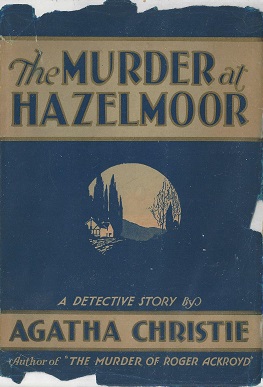
The Sittaford Mystery is a work of detective fiction by British writer Agatha Christie, first published in the US by Dodd, Mead and Company in 1931 under the title of The Murder at Hazelmoor and in UK by the Collins Crime Club on 7 September of the same year under Christie's original title. It is the first Christie novel to be given a different title for the US market. The US edition retailed at $2.00 and the UK edition at seven shillings and sixpence (7/6).

Murder in Mesopotamia is a work of detective fiction by British writer Agatha Christie, first published in the UK by the Collins Crime Club on 6 July 1936 and in the US by Dodd, Mead and Company later in the same year. The UK edition retailed at seven shillings and sixpence (7/6) and the US edition at $2.00. The cover was designed by Robin McCartney.

Death Comes as the End is a historical mystery novel by Agatha Christie, first published in the US by Dodd, Mead and Company in October 1944 and in the UK by the Collins Crime Club in March of the following year. The US Edition retailed at $2.00 and the UK edition at seven shillings and sixpence (7/6).

They Came to Baghdad is an adventure novel by Agatha Christie, first published in the United Kingdom by the Collins Crime Club on 5 March 1951 and in the United States by Dodd, Mead and Company later in the same year. The UK edition retailed at eight shillings and sixpence (8/6) and the US edition at $2.50.
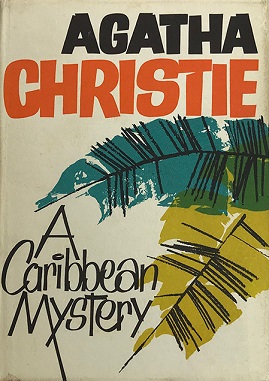
A Caribbean Mystery is a work of detective fiction by British writer Agatha Christie, first published in the UK by the Collins Crime Club on 16 November 1964 and in the United States by Dodd, Mead and Company the following year. The UK edition retailed at sixteen shillings (16/-) and the US edition at $4.50. It features the detective Miss Marple.
Chagar Bazar is a tell, or settlement mound, in northern Al-Hasakah Governorate, Syria. It is a short distance from the major ancient city of Nagar. The site was occupied from the Halaf period until the middle of the 2nd millennium BC.
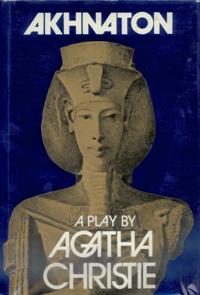
Akhnaton is a play by Agatha Christie. It was written in 1937, around the same time she was writing Death on the Nile. It is set in Ancient Egypt, and followed the exploits of the Egyptian Pharaoh Akhnaton, his wife Nefertiti and his successor Tutankhaton. In writing the play, Christie was assisted by the eminent Egyptologist, Stephen Glanville, who was a friend of both her and her husband, Max Mallowan.

Sir Max Edgar Lucien Mallowan was a prominent British archaeologist, specialising in ancient Middle Eastern history. He was the second husband of Dame Agatha Christie.

Star Over Bethlehem is an illustrated book of poetry and short stories on a religious theme by crime writer Agatha Christie. It was published under the name "Agatha Christie Mallowan". It was published in the UK by Collins on 1 November 1965 in an edition priced at thirteen shillings and sixpence (13/6) and in the US by Dodd, Mead and Company in an edition retailing at $4.95.

Poems is the second of two collections of poetry by crime writer Agatha Christie, the first being The Road of Dreams in January 1925. It was published in October 1973 at the same time as the novel Postern of Fate, the final work she ever wrote.
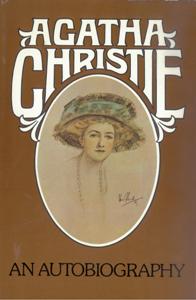
An Autobiography is the title of the recollections of crime writer Agatha Christie published posthumously by Collins in the UK and by Dodd, Mead & Company in the US in November 1977, almost two years after the writer's death in January 1976. The UK edition retailed at £7.95 and the US edition at $15.00. It is by some considerable margin the longest of her works, the UK first edition running to 544 pages. It was translated and published in Greek, Italian, Polish, Portuguese, Hungarian and Spanish.

Agatha Christie (1890–1976) was an English crime novelist, short-story writer and playwright. Her reputation rests on 66 detective novels and 15 short-story collections that have sold over two billion copies, an amount surpassed only by the Bible and the works of William Shakespeare. She is also the most translated individual author in the world with her books having been translated into more than 100 languages. Her works contain several regular characters with whom the public became familiar, including Hercule Poirot, Miss Marple, Tommy and Tuppence Beresford, Parker Pyne and Harley Quin. Christie wrote more Poirot stories than any of the others, even though she thought the character to be "rather insufferable". Following the publication of the 1975 novel Curtain, Poirot's obituary appeared on the front page of The New York Times.

Katharine Elizabeth, Lady Woolley was a British military nurse and archaeologist who worked principally at the Mesopotamian site of Ur. She was married to archaeologist Leonard Woolley.

Hammoudi ibn Ibrahim, was an Arab archaeological foreman who managed workers at major excavations in the Middle East during the first three decades of the twentieth century. Sheikh Hammoudi, as he was known, came from the northern Syrian town of Jarabulus, located on the western bank of the Euphrates River, just south of the present-day Syrian-Turkish border. He worked closely with noted British archaeologists T.E. Lawrence, Leonard Woolley, Katharine Woolley, and Max Mallowan. Mallowan's wife, Agatha Christie, also participated in excavations and wrote about Hammoudi in her memoirs. Among the sites he managed, coordinating workforces of dozens or even hundreds of local workers, are Carchemish, on the border of Turkey and Syria; Ur, in southern Iraq; Tell Atchana, the site of a Bronze Age city state called Alalakh, in the Hatay province of Turkey; and Chagar Bazar and Tell Brak in Syria. In the 1940s, Sheikh Hammoudi became an elected member of the Syrian Parliament. For his service to British interests during World War II, Hammoudi in 1949 won the King's Medal for Service in the Cause of Freedom (KMS).

Robin Halliday Macartney FRIBA was a British architect, painter and illustrator. Today he is mainly remembered as the designer of four book covers for Agatha Christie, who immortalized him as "Mac" in her archaeological memoir Come, Tell Me How You Live. Macartney began his working life as excavation architect in the Near East and then entered the service of the Public Works Department. He was active in Cyprus, Sierra Leone and Nyasaland before retiring to Portugal. Two of his buildings have since become presidential residences.


















